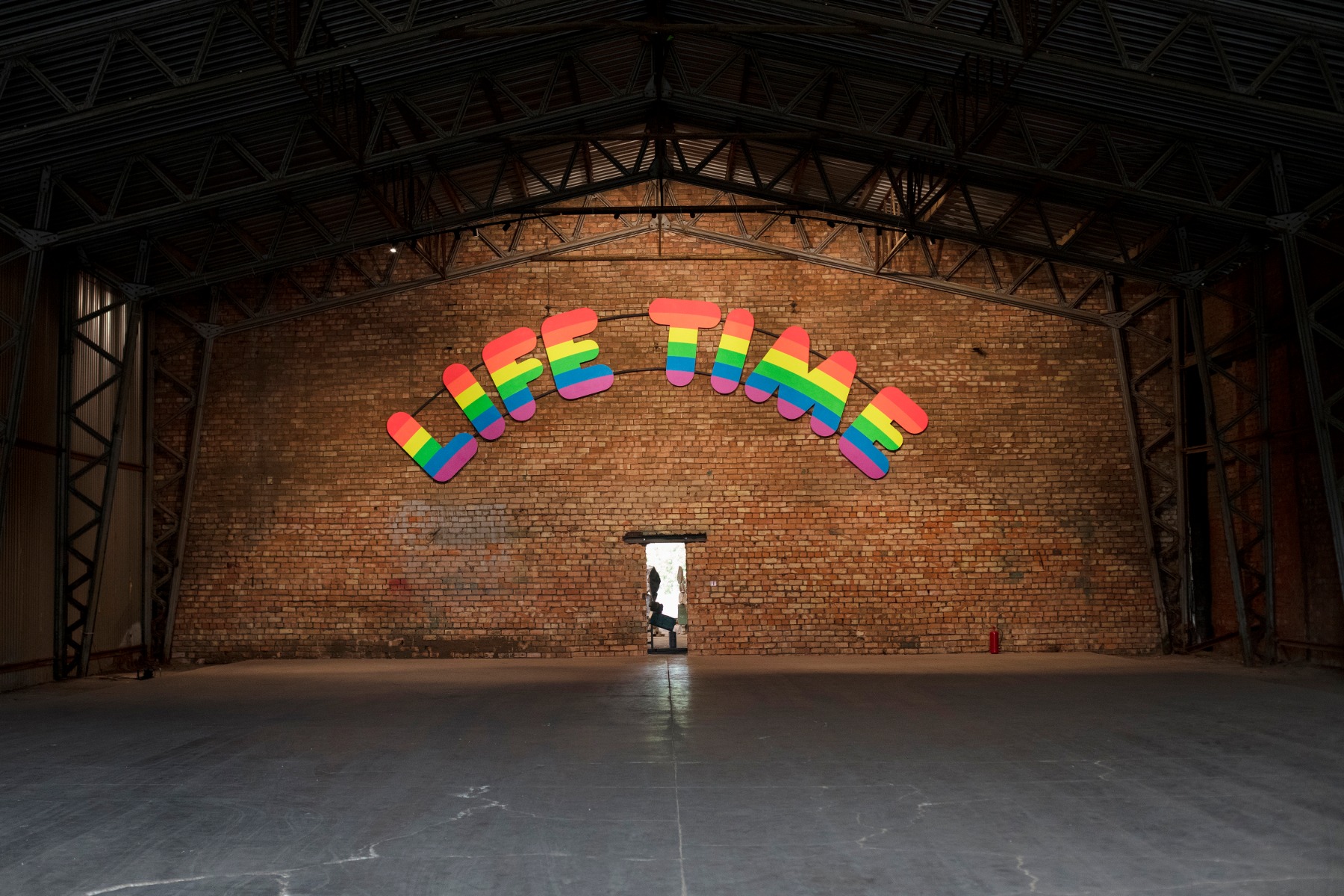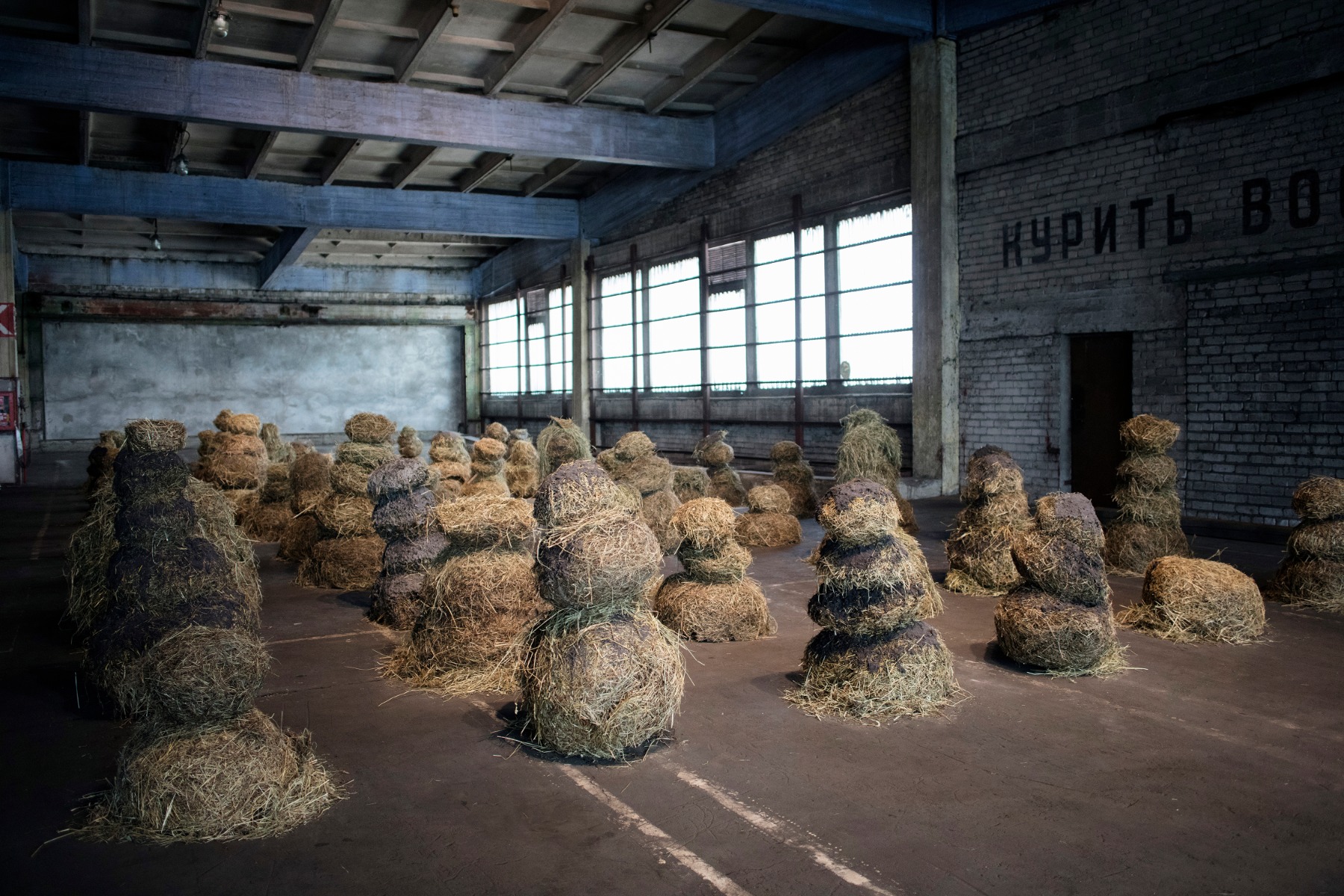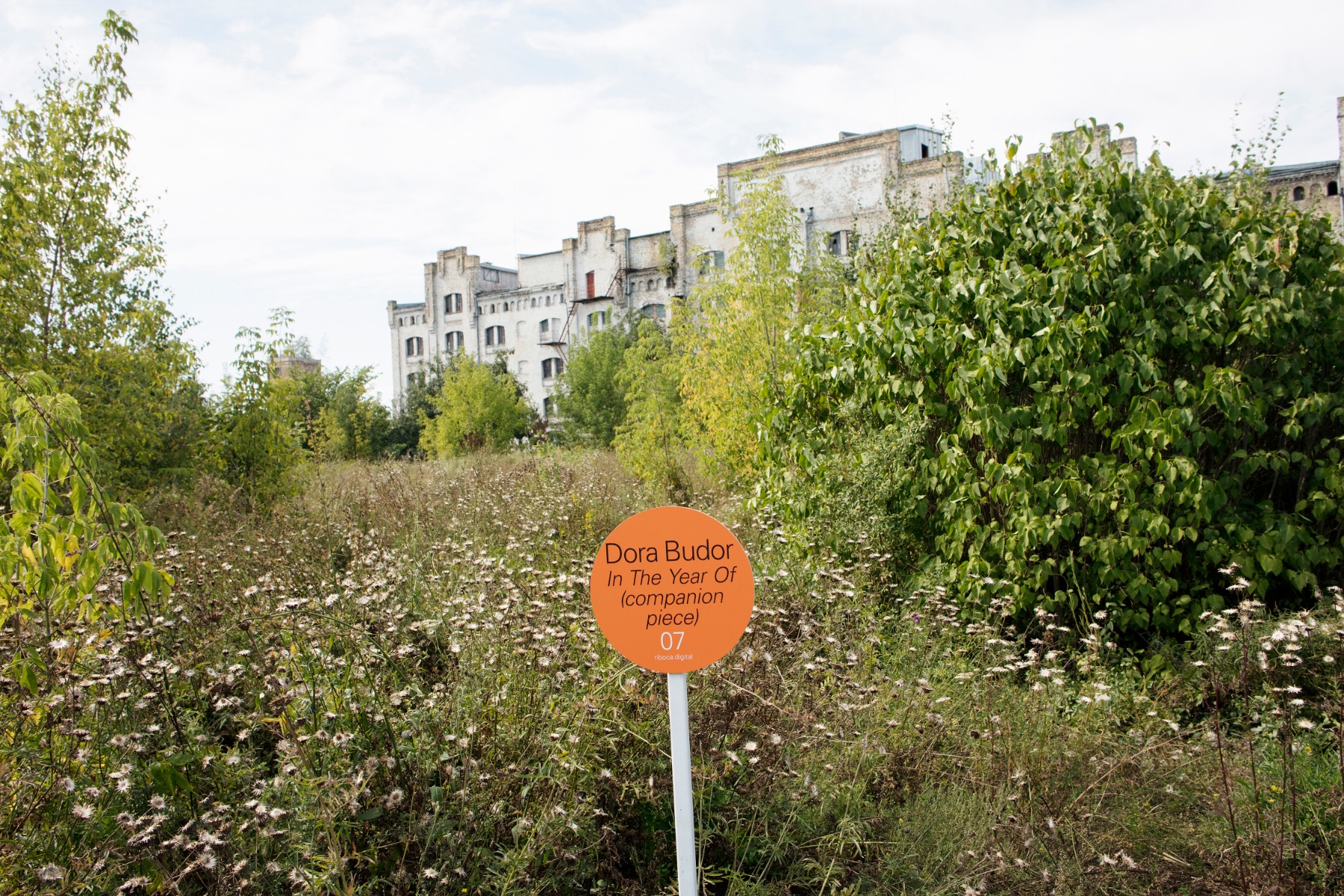
Compulsory Blessing
A Rigans' impressions of the 2nd Riga International Biennial of Contemporary Art – RIBOCA2
Andrejsala is possibly the richest place in Riga in terms of scenery: the large area, combined with a small number of vertically impressive objects, gives one opportunity to experience the surroundings, as well as the view of the surrounding city, in very different ways by just slightly changing the position from which you are observing. If your position of observing is outside of Andrejsala, objects like the industrial chimney and the white facade of the port elevator make the place just as unmistakable. Due to fences, private properties and other zoning issues, only certain segments of the territory are available to Rigans on a daily basis, such as the pier establishments enjoyed by wine lovers. Thanks to the miraculous fact that the second edition of the Riga International Biennial of Contemporary Art (RIBOCA), titled and suddenly it all blossoms, is actually taking place, the public has the chance to experience this unusual territory from new viewpoints and perspectives for at least three weeks.
Ugo Rondinone. life time
The long way through the exhibition begins with an outdoor prelude. Upon entering the first hangar, the reproduction of Ugo Rondinone’s sculpture life time asks a riddle in two charged words, and raises questions about what to expect next. Will it be a matter of life and death, or some kind of period of life? Or will the visitor simply have ‘the time of one’s life’? Immediately after that we go down a narrow aisle leading to a hall where we are welcomed by a group of fantastically balanced stones arranged by Bridget Polk. They appear timeless, unchanging and volatile at the same time, their still silhouettes reminiscent of the rows of mysterious figures guarding Easter Island; they could well have been standing here for thousands of years and could continue to stand for thousands more, but at the same time, when you look closely at each composition it seems unfathomable that they can stand for even a few seconds. Perhaps one need not go any further to get a metaphorical grasp of the whole exhibition, and even the fate of the Riga Biennial in general. The first edition of RIBOCA two years ago, which although conceptually already talked about the infinite and the fading, was in itself a full-blooded, seemingly resource-limitless contemporary art event that confidently presented itself as having arrived here for good – continuing with successive editions every two years ad infinitum, ambitiously illuminating Riga as a place that participates in a powerful, eternal and global conversation about art. This (if not loudly proclaimed, then definitely intended) vision was fundamentally shattered by an annoying microorganism that exposed many seemingly invulnerable and self-sufficient structures of the world as fragile and ready to collapse at any moment – just like any of Polk's balancing rock towers. Last summer when I spoke with head curator Rebeca Lamarche-Vadel, apocalyptic scenarios and the reaction to them had already crystallised as the guiding principle of RIBOCA2. No one, however, foresaw that the apocalypse would actually arrive in the meantime, and that the once-imaginary potential attitudes would now have to be implemented ‘for real’.
Bridget Polk. Balancing Rocks and Rubble
Going further along the harbour elevator building, whose haunted, awe-inspiring façade I had never before come so close to, you arrive at an old paintball field. Within these still-standing structures, artist Anastasia Sosunova has allowed a lost community to leave behind archaeological artefacts that tell of a strange and inexplicable, but very real, life. The aesthetics of the curtain doors, furniture, mirrors, paintings, and various indefinable objects are reminiscent of the terrifying phantasmagoria from the first season of the series True Detective, where in the swampy despair of southern Louisiana, investigators found very similar clues left behind by a mysterious religious fanatic group. The whole work is literally spooky because it speaks of an existence that both is and is not here at the same time, and that does not exist in the usual sense of being but whose presence is felt and frightening in its indecipherability. This is not the only decidedly spooky work in the exhibition: later we will also see Augustus Serapinas’ Mudmen, and the Religious Libertarians by Nikolay Smirnov, not to mention real ghosts – the works that were supposed to be in the exhibition but couldn’t make it because of the pandemic, but their assigned space was left empty so that they can be imagined as being there. For example, Margarita Umo's work, which most likely would have become one of the highlights of the biennial, is now embodied only in the room attendant’s description of what could have been, a narrative that she tirelessly repeats to each subsequent visitor or group of visitors. There, in the corner of the room, we are to imagine the silhouette of the back of a half-drowned whale. The RIBOCA2 exhibition requires a similar exercise of the imagination for some other works or parts of works as well – a really rare occurrence for a contemporary art exhibition. The choice to leave the artist's presence in the exhibition despite the very intangible presence of the work is a bold decision, sure to cause confusion for many visitors. Of course, this may lead to reflection both on the conditions of materiality of a work of art and on contemporary art as just a normal part of the current system of relationships – the fragility and unsustainability of which having been revealed by the mentioned microorganism. The biennial is clearly not embarrassed by this weakness and humbly accepts it as evidenced by, among other things, leaving the original written plans for the missing works (but crossed out) in the annotations and textual materials.
Anastasia Sosunova. Habitaball
We continue along the meadows, where this summer Vija Eniņa has sown and planted meadow flowers usually not seen in Andrejsala, and then we reach the place where Dora Budor reminds us to keep an eye out for the non-humanoid visitors to the exhibition who will be living here throughout the biennial – a pack of friendly, slightly shabby dogs. Here we are – for the first time, really – being warned that we are confronting a conscious and insistent detachment from what a culturally educated audience expects contemporary art should ‘be like’. The exhibition, which consists of 46 works in total, contains an unusually small amount of what is considered ‘usual’: conceptualism, art’s self-reflection on itself and its history, ironic play on what the viewer observes, and so on. By including into the fold of artists the likes of scientists, botanists, mathematicians, crocheters, acrobats and other rather distant colleagues, Lamarche-Vadel seems to continue to enthusiastically push for the ‘interdisciplinarity’ that has been called for by everyone and everything for decades now.
Daina Taimiņa. Dreams and Memories
But what is, in my opinion, really fresh (or, on the contrary, a return to something old and forgotten) about RIBOCA2 is how it is experienced through the senses and not the mind. It’s not as if it’s lacking a healthy dose of conceptualism and social commentary (for example, there’s Alex Baczynsky-Jenkins' video work Faggots, Friends), but in most cases, the selected works provoke various senses or evoke consciousness-transforming experiences instead of just exist as conceptual objects that can be contemplated by a rational mind. Of course, it is difficult to imagine a work that could be perceived without using one’s senses, but in the history of modern and contemporary art, the senses have mostly been only a necessary medium through which to deliver the work of art to the contemplative cognitive apparatus. In this edition of the biennial, many (if not most) of the works call for you to stop at the sensory level and its transforming experience, which must be done immediately before the mind begins to intervene. If the theorists are right – the ones who claim that the mythological worldview ended (or began to end) the moment when humans perceived their observing (and possibly subjugating) consciousness as something separate from the World Tree – then in many cases, the RIBOCA2 exhibition seems to call for a return to that. A call to approach it once again and, perhaps on the way, find ways of existence for the mind which may prove more suitable for successfully inhabiting the modern world than with the usual subject-object relationships that rationalise, order, and subjugate nature.

Finally we end up in the former hangar of the Riga Trade Port, where most of the exhibition is located and which is generally serving as the main home of the biennial for these three weeks. After the prelude that was outdoors, it’s recommended to have a snack or drink because there is still a long way to go. The size of the hangar inside is huge, even brutal, but most of the rooms have been darkened so as to perceive the distances in a more tactile rather than visual sense. And the rest of the journey is ‘a trip’, in the best sense of the word: a concentrated sequence of visual, audible and tactile adventures in which it is recommended to take the rational mind with you as a companion (like a small child who can, at times, annoy with its behaviour), but certainly not as your leader. Valdis Celms’ great metaphysical works – Rhythms of Life and Positron; Katrin Hornek's tactile clay installation A Landmass to Come; the wonderful slow video works De-Extinction (Pierre Huyghe), The Inmost Cell (Eva L’Hoest), and Sounds from Beneath (Mikhail Karikis and Uriel Orlow); and Timur Si-Qin's I Walked Through the Silver Birch Grove – in all of these cases it is recommended to follow the path that the mind takes upon the first impulse created by the work; do not try to control and analyse it. There will be time for that later.
Timur Si-Qin. I Walked Through the Silver Birch Grove 
Despite all of the difficulties faced, the ideas, works, or reproductions of works by various superstars of the art world have arrived at the exhibition. At the same time, it is constantly emphasised – and rightly so – that this biennial, which has been accused of cultural imperialism, wants to organically integrate into the environment and cultural contexts of Riga, Latvia and the Baltics, telling stories that are closely related to its location. It is infinitely interesting to see how artists and intellectuals from very different parts of the world have tried to understand and interpret the local narrative of Riga, Latvia, and the Baltics. Strikingly often it has turned into stories and interpretations of Latvian/Latvia’s folk traditions, songs and mythology, which, although touching, hardly form a significant part of the worldview of most people living here. Despite putting on a folk costume once a year for Midsummer celebrations, or shedding a few tears at the Song Festival, we are largely the same as all other citizens of the globalised neoliberal world. It would even be somewhat amusing if RIBOCA2 effectively reminded the local urban public of the value that their ancestral traditions and mythology have or could have.
Augustas Serepinas. Mudmen
The exhibition’s perceptibility, saturation, and also attempt to establish intercultural dialogue in a local context are factors that I think make this large-scale exhibition unusually egalitarian and accessible to a wider audience (which I can state after having spoken to personal acquaintances who have attended the biennial and shared their impressions thereof). At a time when we need to rethink how to live, this factor cannot be underestimated. The form in which, despite everything, RIBOCA2 has managed to materialise in Andrejsala, hides within it many opportunities to be inspired by ways in which we can adapt to ‘the new normal’. Again, largely because it is more of an adventure than a lesson.
Dora Budora. In The Year Of (companion piece)
This contrast, the dialectic between the rational and the magical, which in the concept for RIBOCA2 took the form of the word ‘re-enchantment’, repeats in the history of ideas: medieval Catholic scholastics against Christian mystics; the Apollonic vs the Dionysian; the Enlightenment’s complaints and the response of romanticism and Sturm und Drang – attempts at ridding the world of a supernatural veil and then ‘conjuring’ it back again repeats itself every so often. This time is perhaps different in that the apocalypse – or its prelude – has indeed already been experienced, and we perhaps see more clearly than ever the shortcomings of an enchanted world. It’s a position where indulging in the experience of enchantment is tempting. The 2nd Riga Biennial provides the opportunity for such an experience in a very saturated way, and it is very likely that the enormous forced transformation it had to undertake to result in this form will ultimately be perceived as a blessing.

My top 5:
Bridget Polk. Balancing Rocks and Rubble
Pierre Huyghe. De-Extinction
Tomas Saraceno. Arachnomancy
Agnese Krivade. The Hotel of St. Christopher
Mikhail Karikis / Uriel Orlow. Sounds From Beneath